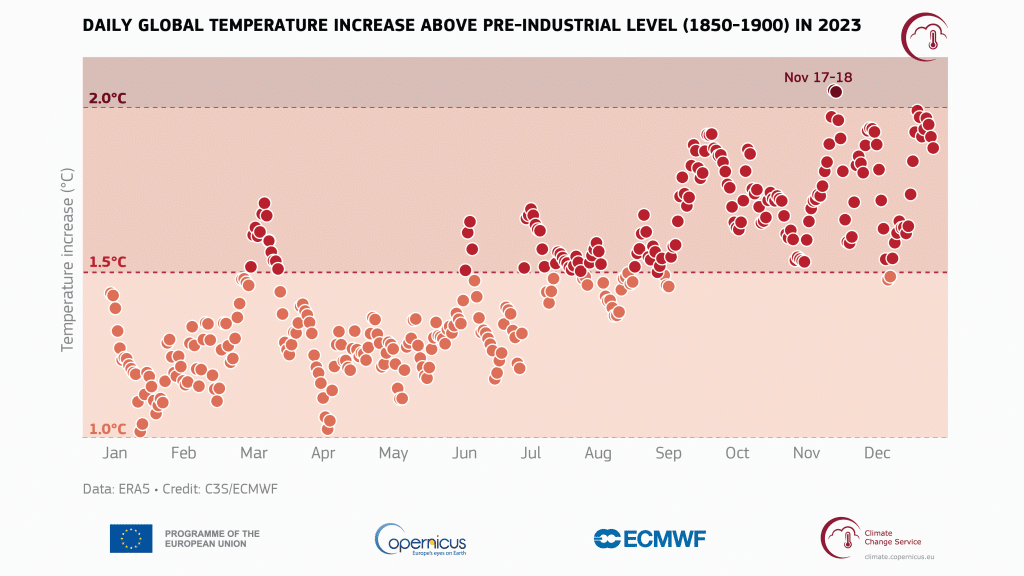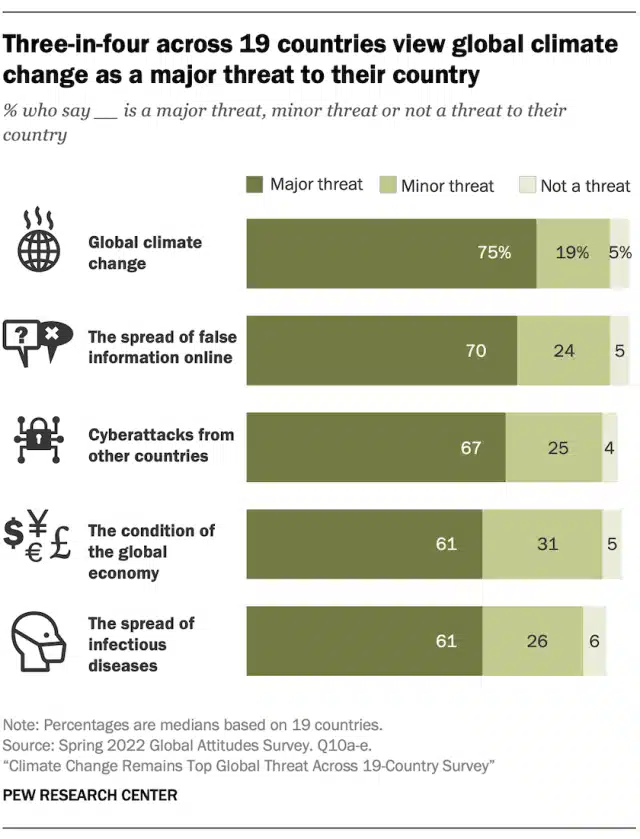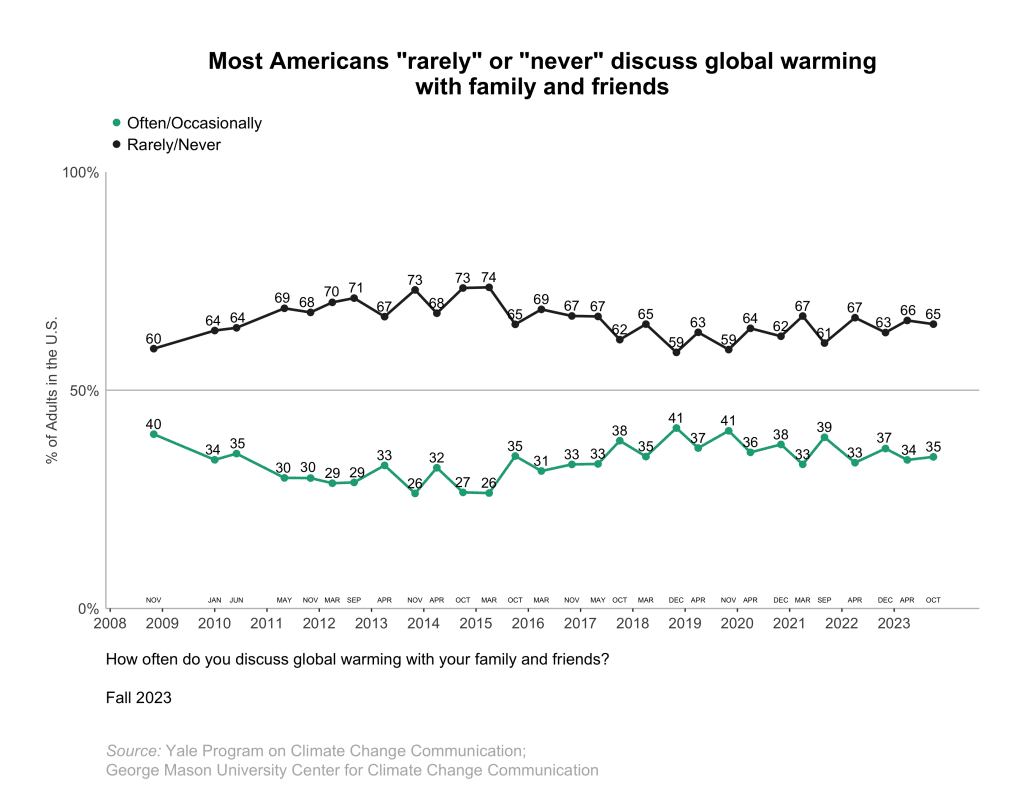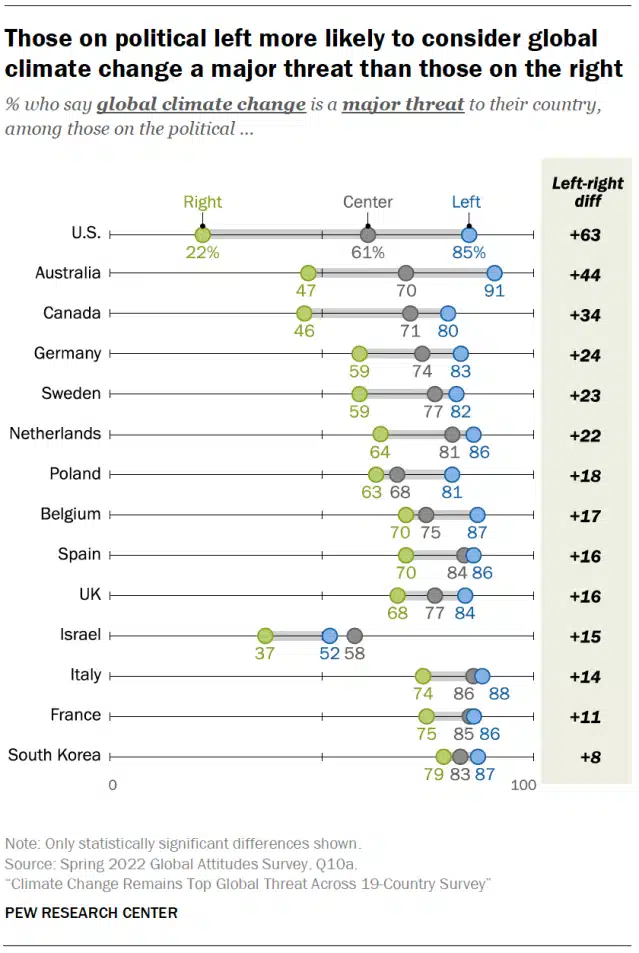2024 will be a pivotal year for democracy, with roughly half of the human population called to the polls. A lot is at stake, especially for the climate. In this article, Earth.Org looks at how perceptions of climate change have shifted in recent decades and how the urgency of addressing the rapidly unfolding climate crisis has fostered a new breed of environmentally conscious voters who are keenly aware that their ballot choices can shape the fate of their planet.
—
Some 4 billion people – roughly half of the human population – are eligible to vote this year, making 2024 the biggest global election year of all time and a pivotal one for democracy.
Beyond their immediate national impact, elections hold significant implications for global stability and the pursuit of sustainable development. As the world grapples with complex challenges such as climate change, social inequality, and geopolitical tensions, understanding the critical role of elections in fostering democracy and maintaining global stability becomes paramount.
But while topics such as the economy and jobs, healthcare, social welfare, governance and security have always dominated the political agenda, recent events have brought another subject to the top of the priority list: climate change.
Context
2023 went down in history as the hottest year ever recorded, with global average temperatures at 1.48C above pre-industrial levels. This is dangerously close to the 1.5C threshold set out in the landmark 2015 Paris Agreement, beyond which some effects of climate change start to become irreversible.
Climate records tumbled “like dominoes”, with surface and ocean temperatures reaching levels never seen before and extreme weather events unfolding incessantly and bringing about devastation and loss around the world.

Atmospheric carbon dioxide (CO2) levels reached historic highs last May and are forecast to keep rising in 2024 at a much higher speed than that required to stay on track with the 1.5C goal. Studies assessing the size of the world’s remaining carbon budget – the net amount of CO2 we have left to emit before we exceed the Paris limit – say we only have six years left. Some even argue that the limit will be breached at some point this year.
Regardless of the exact timeframe, the science is clear: we are running out of time.
One-quarter of humanity is drought stricken amid alarming changes in global water cycles; heat and humidity levels are expected to reach lethal levels for hours, days, and even weeks in some parts of the world by the end of the century, making it impossible to stay outdoors; air pollution is cutting life expectancy by up to five years in some parts of the world; and rapidly rising sea levels are threatening millions of people living in coastal areas.
Against this backdrop, growing concerns about the health of our planet and a notable shift in public awareness about the urgent need to address global warming have translated into increased pressure on political leaders and parties to prioritise climate action in their electoral agendas.
You might also like: Scientists Deliver ‘Final Warning’ on Climate Change, Say 1.5C of Global Warming ‘Likely’ in Near Term
From Hoax to Global Threat
In the United Nations Development Program’s (UNDP) 2021 Peoples’ Climate Vote survey, said to be the largest public opinion survey on climate change in history, a staggering 64% of the 1.2 million respondents recognised that “climate change is a global emergency.”
Other major surveys echoed similar sentiments. People around the world increasingly recognise climate change as a serious and imminent threat to the planet and acknowledge the indisputable role humans played in exacerbating this global crisis. In Pew Research Center’s annual Global Attitudes survey, the number of respondents identifying climate change as a “major threat” went from 54% in 2014 to a staggering 71% in 2022. And as climate change awareness soars, the number of people denying it falls.

A recent survey of more than 1,000 Americans published in January 2024 by the Yale University Program on Climate Change Communication found that those who believe climate change is happening outnumbered those who do not five to one. Interestingly, the number of people saying that climate change was a hoax fell to 39% compared to 51% in the 2011 iteration of the survey. But despite increasing awareness, engagement on the matter remains low, as responses to questions about personal and social engagement with global warming show. 65% of surveyed Americans said they “rarely” or “never” discuss the issue with family and friends and only 35% said they do so “occasionally” of “often”.

Youth
Young people demonstrate a more profound comprehension and consciousness of climate change compared to adults and older generations, with global climate movements such as Greta Thunberg’s Fridays for Future bringing the topic into the mainstream in recent years and Generation Z been nicknamed the climate generation. Since then, the number of youth climate groups has grown exponentially around the world and climate protests have taken different shapes. Public disruption tactics have been on the rise in recent years, with groups such as Just Stop Oil and Extinction Rebellion making the headlines and often dividing the public opinion with their actions.
You might also like: Are Climate Activists Reaching Too Far?
But younger generations are not just more in touch with climate change; they are also increasingly worried about it. In 2020, environmental non-profit Friends of the Earth estimated that over two-thirds of young people aged 18-24 experience climate anxiety, a feeling of distress, guilt, and helplessness about climate change and its impacts on the landscape and human existence. “As the group of people most likely to see the worsening effects of climate chaos, it’s not surprising that a surge of younger people is increasingly concerned, especially in the face of government inaction,” said Aaron Kiely, climate campaigner for Friends of the Earth.
In December 2021, a group of researchers focussing on climate anxiety surveyed 10,000 young people aged 16-25 across ten countries – Australia, Brazil, Finland, France, India, Nigeria, Philippines, Portugal, the UK, and the US. They reported that participants across all countries were worried about climate change – with 59% “very” or “extremely” worried and 84% “moderately” worried. More than 50% of respondents reported each of the following negative emotions: sadness, anxiety, anger, powerlessness, helplessness, and guilt. But what about older generations?
In a 2003 paper, Scott Wright, a professor at the University of Utah conducting interdisciplinary research in gerontology, contended that “the natural environment has been a missing topic from education and public policy forums concerning an ageing society,” and this does not seem to have changed much by today. Others have identified that older generations may care about the short-term impacts of climate change – like extreme weather, poor air quality, and the spread of infectious diseases – because they are personally affected. However, while there is tons of research on the physical impacts of climate change on the elderly, less is known about the toll it is taking on their mental health. For instance, older generations may experience feelings of guilt and overwhelming anxiety because they feel responsible for destroying the environment and failing to secure a healthy and sustainable future for their children and grandchildren.
More on the topic: How Young Climate Activists Are Making Their Voices Hear
The Rise of the ‘Greens’
The question of whether climate agendas influence voters’ decisions around the world is a tough as the answer changes greatly from country to country. However, polls show that awareness about the topic has increased exponentially in recent years and so has the popularity of the “Greens”, left-wing political parties that believe environmental protection, social justice, and nonviolence are of supreme importance to the sustainable development of human lives and all other living beings.
Currently, Green parties exist in about 90 countries around the world and are unified under the Global Greens, an international organisation that envisions a planet where there is no conflict between our economic needs and the systems of life. While in some parts of the world, the influence of the Greens is minimal and they act mainly in the form of an extra-parliamentary opposition, in others they are remarkably popular and actively engage in elections.
You might also like: The Rising Popularity of Green Political Party Beliefs
Green Party supporters are typically left-leaning. Indeed, research shows that those on the political left are generally more likely to consider global warming a major threat and advocate for more policies to fight it. They are also, generally speaking, young. This claim is backed by a 2023 study looking at the rise in electoral support for Green parties in Western Europe. By comparing data covering 40 elections in 11 Western European countries, researchers found that “each new generation is more supportive of the Greens than the generation before.”

What Climate Policies Do People Want?
In a working paper published in June 2022, the Organisation for Economic Cooperation and Development (OECD) examined international attitudes toward climate policies by surveying over 40,000 people across 20 countries that collectively represent 72% of global carbon dioxide (CO2) emissions. The study revealed that support for climate policies is dependent on three crucial factors: the perceived effectiveness of these policies in reducing emissions, the impact of such policies on lower-income households, particularly in terms of inequality, and individuals’ own gains and losses in relation to these policies. It concluded that providing information that directly addresses these key concerns can substantially increase support for climate policies in many countries, highlighting the importance of understanding the factors that shape support for climate policies and highlights the need for tailored communication strategies to effectively garner public backing.
As for the specific policies that people want to see, it is useful to go back to the aforementioned UNDP Peoples’ Climate Vote survey, which questioned its 1.2 million participants about the most important climate policies that governments should focus on to address the climate crisis. The respondents identified conservation of forest and land, renewable energy, sustainable farming, and green businesses and jobs, the importance of which was directly linked to and influenced by the national context.
For example, people living in high-emitting countries – such as the US, Canada, Germany, South Africa, Poland, and Japan – believe their governments should give priority to clean energy development. In nations that are highly dependent on agriculture, such as the Philippines, Indonesia, Ecuador, and Egypt, climate-friendly farming policies are highly desired. And in nearly all G20 countries, which are among the strongest economies in the world, people want to see more investment in green businesses and jobs.
Considering the rapid increase in the frequency and intensity of extreme weather events not just in developing countries – historically the most vulnerable to climate change – but also in highly developed nations, the general consensus among all surveys’ respondents about the need for adaptation and resilience, from early warning systems to adequate infrastructure, comes as no surprise.
You might also like: 15 Biggest Environmental Problems of 2024
Will Climate Change Shape the Course of 2024 Elections?
Climate change has increasingly become a prominent and critical issue in recent years, garnering widespread attention and concern globally. Its impact on various aspects of society, including the economy, public health, and the environment, has led to increased awareness and a growing demand for action.
Given the significance of climate change as a pressing issue, it is plausible that it will play a role in shaping the course of this year’s elections, though it is important to also keep in mind that factors including the specific context of the elections, the candidates’ positions on climate change, and voters’ priorities of voters vary greatly across different countries and regions. Factors such as the level of public awareness, the severity of climate-related events, and the political and economic landscape will all contribute to the issue’s salience in electoral campaigns.
In recent years, we have witnessed a growing political divide regarding climate change, with some political parties and candidates emphasizing the urgency of addressing the issue, while others express skepticism or downplay its importance. This divide can lead to differing policy proposals and approaches, which can in turn influence voters’ decisions.
Furthermore, public opinion on climate change has been evolving, with a significant portion of the population expressing concern and demanding action. This growing awareness and activism can influence the electoral landscape, as candidates may be compelled to address climate change and present comprehensive plans to mitigate its effects.
While it is difficult to predict the specific impact of climate change on the 2024 elections, it is reasonable to expect that an unprecedented number of voters will be influenced by it. As the urgency to address climate change grows, candidates and political parties are likely to face increasing pressure to articulate their positions and propose policies to address this critical issue.
This story is funded by readers like you
Our non-profit newsroom provides climate coverage free of charge and advertising. Your one-off or monthly donations play a crucial role in supporting our operations, expanding our reach, and maintaining our editorial independence.
About EO | Mission Statement | Impact & Reach | Write for us


















